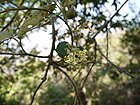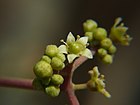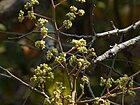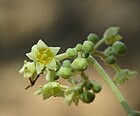Note: This is a project under development. The articles on this wiki are just being initiated and broadly incomplete. You can Help creating new pages.
Ziziphus rugosa
Ziziphus rugosa is a spiny, evergreen tree growing around 5 - 9 metres tall. The plant is harvested from the wild for local use as a food and a medicine.
Contents
- 1 Uses
- 2 Parts Used
- 3 Chemical Composition
- 4 Common names
- 5 Properties
- 6 Habit
- 7 Identification
- 8 List of Ayurvedic medicine in which the herb is used
- 9 Where to get the saplings
- 10 Mode of Propagation
- 11 How to plant/cultivate
- 12 Commonly seen growing in areas
- 13 Photo Gallery
- 14 References
- 15 External Links
Uses
Swollen gums, Toothaches, Menorrhagia.[1]
Food
Ziziphus rugosa can be used in Food. Ripe fruits are eaten raw.[2]
Parts Used
Chemical Composition
It contains lupeol, betulin, betulinic aldehyde, betulinic acid, alphitolic acid, euscaphic acid, zizyberenalic acid, and β−sitosterol etc.[3]
Common names
| Language | Common name |
|---|---|
| Kannada | Belahadu, Kanika |
| Hindi | Churna, Suran |
| Malayalam | Thodali, Tutari |
| Tamil | Totari |
| Telugu | Gottichettu |
| Marathi | Toran |
| Gujarathi | |
| Punjabi | |
| Kashmiri | |
| Sanskrit | Ghontaa |
| English | Wild Jujube, Wrinkled Jujube |
Properties
Reference: Dravya - Substance, Rasa - Taste, Guna - Qualities, Veerya - Potency, Vipaka - Post-digesion effect, Karma - Pharmacological activity, Prabhava - Therepeutics.
Dravya
Rasa
Guna
Veerya
Vipaka
Karma
Prabhava
Nutritional components
Ziziphus rugosa Contains the Following nutritional components like - Vitamin-A, B and C; Betulinic acid, Citric acid; Carotene Flavonoides, Lupeol; Quercetin; Tannins; Calcium, Copper, Iron, Magnesium, Manganese, Phosphorus, Potassium, Sulphur, Zinc[2]
Habit
Identification
Leaf
| Kind | Shape | Feature |
|---|---|---|
Flower
| Type | Size | Color and composition | Stamen | More information |
|---|---|---|---|---|
| {{{5}}} |
Fruit
| Type | Size | Mass | Appearance | Seeds | More information |
|---|---|---|---|---|---|
Other features
List of Ayurvedic medicine in which the herb is used
Where to get the saplings
Mode of Propagation
Seeds, Division of root suckers.
How to plant/cultivate
This species is an important host for the parasitic scale insect, Laccifer lacca (lac insect)[6]. Ziziphus rugosa is available through December to February[2].
Commonly seen growing in areas
Riverbanks, Shorea forest, Sparse forests, Thickets on hills, Sunny places on mountains.
Photo Gallery
References
- ↑ Indian Medicinal Plants by C.P.Khare
- ↑ 2.0 2.1 2.2 "Forest food for Northern region of Western Ghats" by Dr. Mandar N. Datar and Dr. Anuradha S. Upadhye, Page No.155, Published by Maharashtra Association for the Cultivation of Science (MACS) Agharkar Research Institute, Gopal Ganesh Agarkar Road, Pune
- ↑ Chemical constituents
- ↑ Common names
- ↑ [Morphology]
- ↑ Cultivation
External Links
- Ayurvedic Herbs known to be helpful to treat Swollen gums
- Ayurvedic Herbs known to be helpful to treat Toothaches
- Ayurvedic Herbs known to be helpful to treat Menorrhagia
- Herbs with Fruits used in medicine
- Herbs with common name in Kannada
- Herbs with common name in Hindi
- Herbs with common name in Malayalam
- Herbs with common name in Tamil
- Herbs with common name in Telugu
- Herbs with common name in Marathi
- Herbs with common name in Sanskrit
- Herbs with common name in English
- Habit - Evergreen tree
- Index of Plants which can be propagated by Seeds
- Index of Plants which can be propagated by Division of root suckers
- Herbs that are commonly seen in the region of Riverbanks
- Herbs that are commonly seen in the region of Shorea forest
- Herbs that are commonly seen in the region of Sparse forests
- Herbs that are commonly seen in the region of Thickets on hills
- Herbs that are commonly seen in the region of Sunny places on mountains
- Herbs







